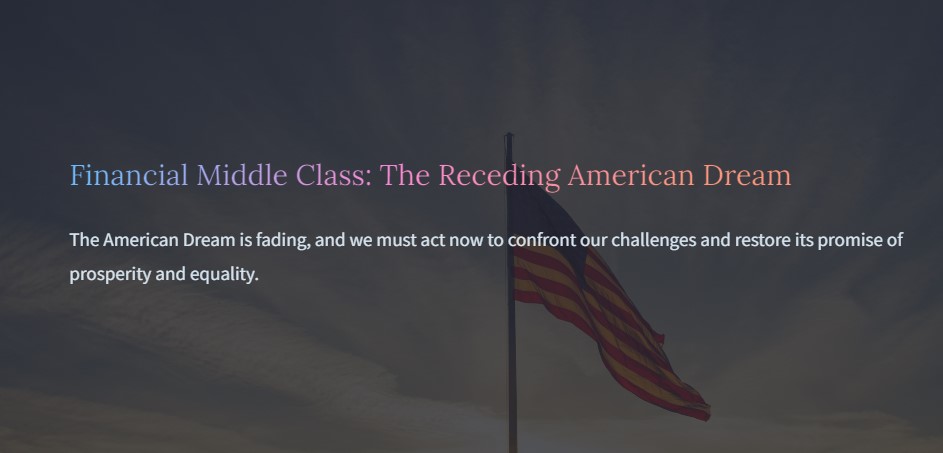The Receding American Dream: Navigating the Obstacles to Equality and Prosperity
The American Dream, once a symbol of hope and boundless opportunity, faces formidable challenges in the modern era.
As aspirations of success, upward mobility, and a better life through hard work and determination have become increasingly difficult for many, concerns about the fading American Dream have gained prominence.
The hallmarks and the basic trappings of the middle-class American dream, food, housing, healthcare, and transportation, have increased exponentially.
We launched the “Financial Middle Class” blog to provide unbiased financial planning guidance to the declining middle class.
Today, America’s birthday, is an excellent time to delve into the key factors contributing to its receding nature and shed light on the hurdles individuals face striving for a brighter future.
Income Inequality
Income inequality has reached alarming levels in the United States, threatening the foundation of the American Dream. According to the World Inequality Database, the top 1% of earners in the U.S. captured over 20% of the country’s total income in 2020.
Meanwhile, the bottom 50% accounted for just 11% of the income. This stark disparity not only amplifies social divisions but also restricts economic mobility.
As wealth becomes concentrated among a select few, the middle class finds it increasingly challenging to climb the socioeconomic ladder.
Rising Costs of Education
The rising education costs have become a significant barrier to achieving the American Dream.
Over the past few decades, tuition fees at public colleges and universities have skyrocketed. According to the College Board, the average annual cost of tuition and fees at four-year public institutions increased by 72% (adjusted for inflation) between 2000 and 2020.
This expense surge burdens students with substantial debt, limiting their ability to invest, save, or pursue entrepreneurial ventures. In 2021, outstanding student loan debt in the U.S. surpassed $1.7 trillion, making it harder for graduates to achieve financial stability.
In a heartbreaking turn of events, the hopes of debt-ridden students seeking relief from their financial burdens were crushed when the Supreme Court struck down the Biden administration’s student debt relief plan.
These students had been longing for respite, their dreams and aspirations overshadowed by the weight of their debts. They believed that a helping hand would come from the highest power level.
However, the Supreme Court’s decision dealt a severe blow, leaving these students stunned and disillusioned. The plan they had pinned their hopes on was mercilessly dismantled, leaving them grappling with the enormity of their financial obligations.
What was once seen as an opportunity to break free from the chains of debt became entangled in bureaucracy and legal complexities.
Lack of Affordable Housing
The dream of homeownership, a cornerstone of the American Dream, has become increasingly unattainable for many due to a lack of affordable housing.
The National Low Income Housing Coalition estimates a shortage of over 7 million affordable rental homes in the U.S.
This shortage and escalating property prices in urban areas have pushed homeownership out of reach for a significant portion of the population.
In 2020, the homeownership rate in the U.S. dropped to 65.6%, the lowest level since the 1960s. High rental costs strain individuals and families, leaving them with limited resources to invest in education, healthcare, or saving for the future.
Limited Social Mobility
Social mobility, the ability to move up the economic ladder regardless of background, is declining in the United States.
According to research by economists from Harvard and Stanford, children from low-income families face significant hurdles in achieving upward mobility.
Factors such as unequal access to quality education, limited social networks, and systemic biases impede their progress.
For instance, a child born into the bottom income quintile has less than a 10% chance of reaching the top quintile. This lack of mobility perpetuates a cycle of inequality and erodes the essence of the American Dream.
The Decline in Economic Opportunities
The evolving economy, driven by globalization, technological advancements, artificial intelligence (AI), and automation, has declined traditional economic opportunities.
Industries that once offered stable and well-paying jobs have undergone significant transformations, leaving many individuals displaced and struggling to find suitable employment.
The rapid rise of automation, for example, has threatened manufacturing jobs. While providing flexible work arrangements, the gig economy often lacks job security and benefits. Even white-collar jobs have begun to feel the unyielding impact of artificial intelligence (AI).
According to the U.S. Bureau of Labor Statistics, 10.6% of U.S. workers were employed in alternative work arrangements in 2017. This shift, like work, has contributed to a decline in stable employment, undermining the stability necessary to achieve long-term financial success.
Conclusion
The receding American Dream is a wake-up call, highlighting the need to address the challenges hindering equality and prosperity. Income inequality, rising education costs, unaffordable housing, limited social mobility, and declining economic opportunities collectively erode the foundations of the American Dream.
It is imperative to enact comprehensive reforms, including policies to reduce income disparities, increase access to affordable education, and promote affordable housing initiatives.
Investing in quality education, fostering inclusive economic growth, and ensuring equal opportunities can pave the way for a revitalized American Dream that remains attainable regardless of background or social status.
